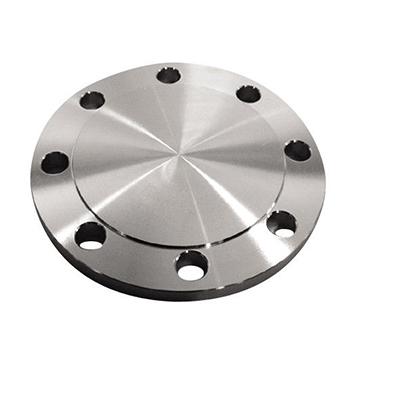The production process of blind flanges
The production process of blind flange can be divided into three types: forging, casting and cutting. Cast flange and forged flange have a shape with accurate size, and advantages such as small workload, and low cost, but they may also have defects like pores, cracks, inclusions. The internal streamline of cast flanges is relatively poor, of which, those cut by lathe are even worse. Compared with cast flanges, forged flanges have better streamline, mechanical performance, compact structure, as well as lower carbon content, and are not easy to rust. But if the forging process is improper, there will still be large or uneven grains, hardening or crack. Besides, the cost of forging is higher than that of casting.
Forged pieces can withstand higher shear and tensile forces than cast pieces, whose advantage is that they can be formed into a more complicated shape and the cost is relatively low. The advantages of forged pieces are their even internal structure, and being without defects like pores or inclusions. The production processes of forged and cast pieces are different. For example, a centrifugal flange is a type of cast flange processed by precise casting methods. Compared to sand casting process, pieces with this kind of casting process have a much finer structure, better quality and problems like loose structure, pores, etc. are not easy to occur. First of all, we need to understand how the centrifugal flange is produced, the techniques of centrifugal casting and the final products.
1. Smelt the selected raw steel into a medium frequency furnace. The temperature of molten steel needs to reach 1600-1700℃;
2. Preheat the metal mold to 800-900℃ and maintain the temperature;
3. Start the centrifuge, pour the molten steel in step 1 into the metal mold after preheating mentioning in step 2;
4. The Casting needs to be naturally cooled to 800-900℃ for 1-10 minutes;
5. Cool the casting with water until its temperature drops at room temperature, take out the casting from the mold.
The forging processes of blind flange generally consist of selecting high-quality steel billet, heating, forming, forging and cooling. And the methods include open die forging, closed die forging, and swage forging. In production, different forging methods are selected according to the quality of the forgings and the bulk of production. Open die forging has low working efficiency, large machining allowance but is of universal use and with simple tools and devices like air hammer, steam-air hammer, hydraulic press for small, medium, or large piece production. So it is commonly used in forging a small batch of products with an uncomplicated shape. Closed die forging has high working efficiency, is easy to use and achieve mechanization and automation. Pieces with closed die forging have a high-accuracy size, small machining allowance, more reasonable distribution of the fibrous structure, and longer service life.

Forged pieces can withstand higher shear and tensile forces than cast pieces, whose advantage is that they can be formed into a more complicated shape and the cost is relatively low. The advantages of forged pieces are their even internal structure, and being without defects like pores or inclusions. The production processes of forged and cast pieces are different. For example, a centrifugal flange is a type of cast flange processed by precise casting methods. Compared to sand casting process, pieces with this kind of casting process have a much finer structure, better quality and problems like loose structure, pores, etc. are not easy to occur. First of all, we need to understand how the centrifugal flange is produced, the techniques of centrifugal casting and the final products.
1. Smelt the selected raw steel into a medium frequency furnace. The temperature of molten steel needs to reach 1600-1700℃;
2. Preheat the metal mold to 800-900℃ and maintain the temperature;
3. Start the centrifuge, pour the molten steel in step 1 into the metal mold after preheating mentioning in step 2;
4. The Casting needs to be naturally cooled to 800-900℃ for 1-10 minutes;
5. Cool the casting with water until its temperature drops at room temperature, take out the casting from the mold.
The forging processes of blind flange generally consist of selecting high-quality steel billet, heating, forming, forging and cooling. And the methods include open die forging, closed die forging, and swage forging. In production, different forging methods are selected according to the quality of the forgings and the bulk of production. Open die forging has low working efficiency, large machining allowance but is of universal use and with simple tools and devices like air hammer, steam-air hammer, hydraulic press for small, medium, or large piece production. So it is commonly used in forging a small batch of products with an uncomplicated shape. Closed die forging has high working efficiency, is easy to use and achieve mechanization and automation. Pieces with closed die forging have a high-accuracy size, small machining allowance, more reasonable distribution of the fibrous structure, and longer service life.


